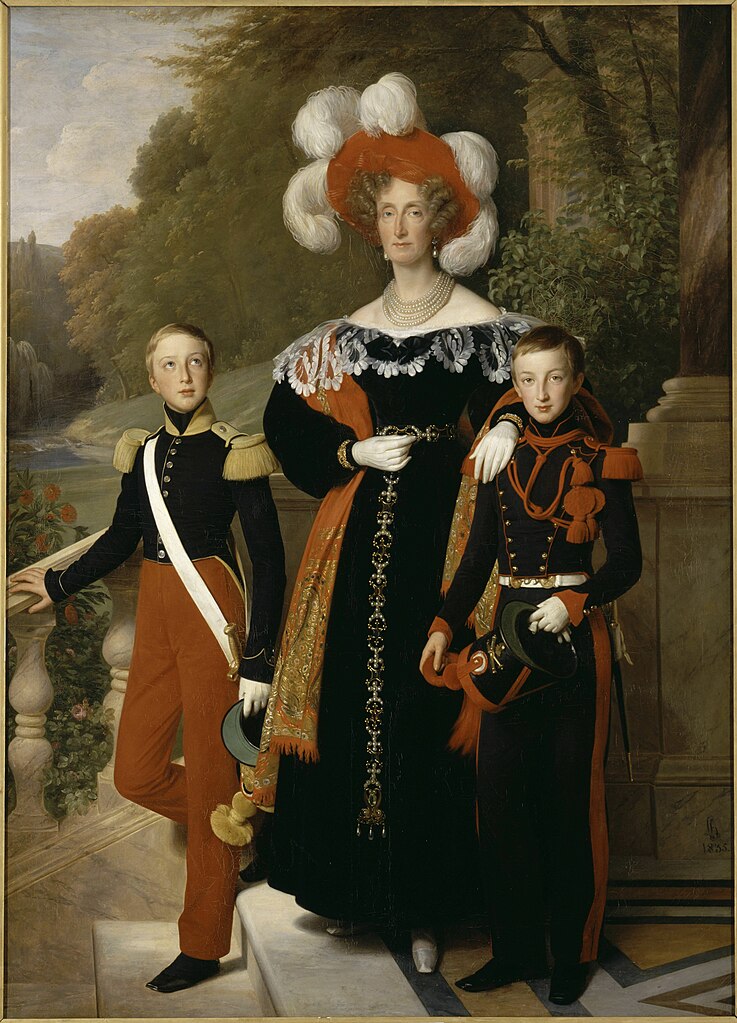Re: Queen Marie Amelie and the French Crown Jewels Archived Message
Posted by Arthur  on January 11, 2017, 1:36 am, in reply to "Re: Queen Marie Amelie and the French Crown Jewels" on January 11, 2017, 1:36 am, in reply to "Re: Queen Marie Amelie and the French Crown Jewels"
There might be several reasons for Queen Marie-Amélie not to use the Crown jewels.
Maybe the "low key" style of the new royal couple - which earned Louis-Philippe the nickname of "Roi bourgeois" - and their taste for family gatherings rather than for lavish Court pageantry implied a lesser use of splendid jewellery. Possibly for the same reason, it took two years after Louis-Philippe's accession to the throne for the royal couple to decide to move from the Palais-Royal (the traditional Parisian palace of the Orleans branch) to the Tuileries Palace (the residential Palace of the French Kings and Emperors from 1789 to 1870). Yet, Queen Marie-Amélie owned a splendid personal collection of jewellery, including almost all types of precious and semi-precious stones (and pearls as well, of course!), and her jewels could hardly be described as "modest", whether by their quality or their quantity!
There might have been a more "political" explanation for the Queen not to wear the Crown jewels, possibly mixed with psychological self-reservations. King Louis-Philippe had received the throne in 1830 through a revolution which had deposed the legitimate King, Charles X (Louis-Philippe's cousin). Charles X had been forced into exile with his family (his son Louis Duke of Angoulême, his daughters-in-law Marie-Thérèse Duchess of Angoulême [herself a first cousin of Marie-Amélie through their common maternal grandmother, Empress Maria-Theresia of Austria] and Marie-Caroline Duchess of Berry [herself the niece of Marie-Amélie through their common Sicilian origin] and his grandson Henri Duke of Bordeaux/Count of Chambord). Maybe there was some kind of decency from the new King and Queen towards their exiled cousins in their choice not to use the Crown jewels. Marie-Amélie herself was quite reluctant about her husband becoming King after the 1830 revolution: not only did she cherish her quiet life of a second-rank member of the Royal family, but she was personally deeply legitimistic, and according to some reports, she would have considered as a "catastrophe" the accession of her husband to the throne. Later in her life, when she lived in exile in England after the 1848 revolution which deposed Louis-Philippe and his death in 1850, she was one of the strongest advocates (even against the adverse opinion of several of her sons) of a reconciliation between her grandson the Count of Paris, head of the Orleans branch, and the Count of Chambord, head of the elder (and legitimate) branch of the Bourbons.
Regarding the keeping of the Crown jewels during Louis-Philippe's reign, Bernard Morel gives interesting information in his book about the French Crown jewels (Les Joyaux de la Couronne de France, 1988).
Charles X, when he fled the revolution-stormed Paris for Rambouillet in July 1830, had taken with him the boxes containing the Crown jewels, but delegates sent by Louis-Philippe, then proclaimed Lieutenant-general of the Kingdom (but still not King) had managed to negociate the return of the jewels to Paris. They were stored in a five-key-locked box; two keys were kept by the Crown jeweller, Evrard Bapst, and one by Kessner, central cashier of the finance ministry (remember the Crown jewels were not considered as personal belongings of the Kings, but were State property, and therefore under the responsibility of the finance ministry). Strangely, for two years (1830-1832), this box was stored in Evard Bapst's private home, kept by a guard night and day.
In 1832, the jewels were controlled and an inventory was made, and the jewels were returned to the Civil List service, in an adjacent wing of the Tuileries Palace (the wing now housing the Musée des Arts Décoratifs, along the Rue de Rivoli). The Crown jewels were kept in a three-key strongbox (one key held by the treasure-keeper of the Civil List Verbois, one by retired inspector Maréchal, and the third one by Constant Bapst, son and successor of Evrard Bapst as Crown jeweller), and the strongbox itself was hidden... inside a brick wall, where the jewels were safely kept until the 1848 revolution!
A few more portraits of Queen Marie-Amélie with some of her jewels:



|
|

